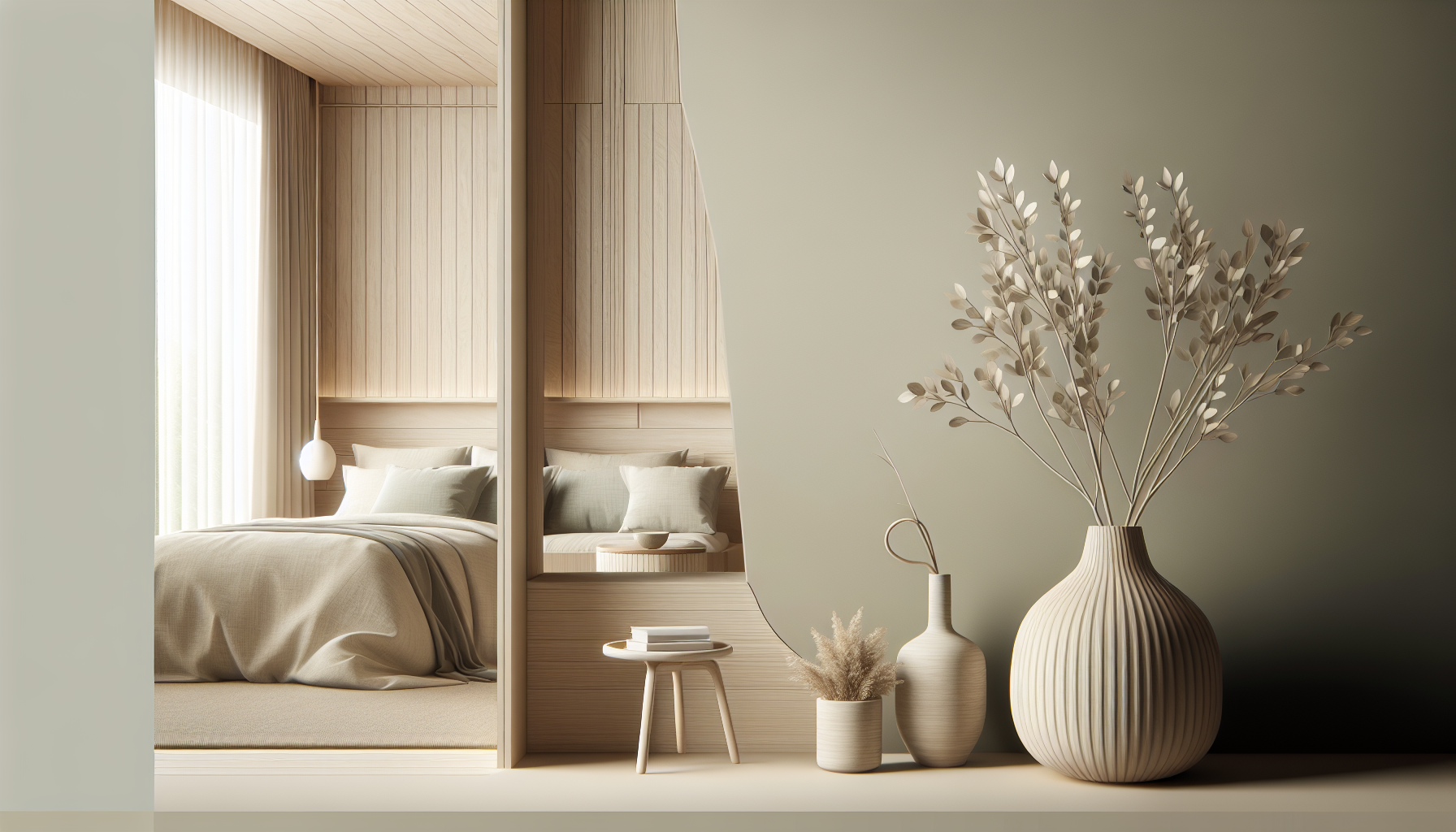What colors come to mind when you think of tranquility and relaxation? If you’re looking to create a calming sanctuary in your bedroom, especially within the serene aesthetic of Japandi design, the colors you choose play a crucial role. Japandi combines the simplicity of Japanese design with the warmth of Scandinavian style, resulting in a space that is beautiful and calming. Let’s explore the most soothing colors that can transform your bedroom into a peaceful retreat.
Understanding Japandi Design
Japandi style is all about minimalism, functionality, and harmony. By blending Japanese sophistication with Scandinavian coziness, this design trend highlights natural elements, clean lines, and a neutral palette. It prioritizes comfort and peace, making it ideal for the bedroom, where relaxation is key.
The Importance of Color in Interior Design
Color impacts your mood and emotional well-being, serving as a powerful tool in interior design. The right shades create a soothing atmosphere, which is essential for a space meant for rest. In a Japandi bedroom, you want to cultivate serenity, so the colors you select should promote relaxation and tranquility.
Calming Colors for a Japandi Bedroom
When considering colors for your Japandi bedroom, think about hues that evoke calmness and simplicity. Here, we’ll identify some of the most calming colors and discuss how they can enhance your space.
Soft Neutrals
Soft neutrals form the backbone of Japandi design. These colors create an airy and spacious feel while still being warm and inviting.
1. Beige
Beige acts as a gentle and versatile backdrop, allowing you to layer other colors and textures. It brings warmth without being overwhelming. You can choose sandy tones or creamier hues depending on your preference. Pairing beige with natural wood accents can enhance the calming vibe.
2. Taupe
Taupe, a blend of gray and brown, provides a grounding effect in a bedroom setting. It works beautifully with wood elements and can prevent the space from feeling too sterile. This color pairs well with soft whites and muted greens for a nature-inspired look.
Earthy Greens
Green is strongly linked to nature and balance. It can evoke feelings of renewal and calm, perfect for a bedroom setting.
3. Sage Green
Sage green is a soft, muted green that resonates with nature. It establishes a serene atmosphere, especially when combined with light-colored woods. Adding some plants or botanical prints can enhance this calming effect, creating a cohesive theme throughout the room.
4. Olive Green
For a bolder yet still serene choice, olive green adds a touch of sophistication while maintaining a sense of calm. This shade complements warmer wooden elements often found in Japandi spaces. Olive can create a peaceful atmosphere when used on one accent wall or in bedding.
Serene Blues
Blue is renowned for its calming properties, making it an excellent color choice for a restful bedroom.
5. Light Blue
Light blue fosters a peaceful and airy feeling in your space. It reminds one of the sky and water, instilling a sense of tranquility. Pairing it with white or light gray can produce a light yet cozy atmosphere.
6. Dusty Blue
Dusty blue offers a slightly muted take on the classic blue shade. It evokes a sense of serenity and adds elegance. This color pairs seamlessly with neutral furniture and textiles, making it a versatile option for your Japandi bedroom.
Warm Whites
Whites are a staple in Japandi design, providing a clean and fresh aesthetic that enhances light and creates a sense of openness.
7. Off-White
Off-white colors, such as ivory or cream, create a softer look than stark whites, adding warmth without losing brightness. These shades work brilliantly with wood accents and textiles, maintaining the natural feel of the room.
8. Soft Gray
Soft gray can act as a beautiful alternative to white. It offers a sense of calmness and pairs well with natural textures. This calming gray can be used in walls, linens, or decor, providing a sophisticated backdrop for other elements.
Muted Terracotta
This earthy color brings warmth and comfort without being too vibrant.
9. Terracotta
Terracotta adds warmth and an organic feel to your bedroom. While it’s a more unusual choice within the Japandi palette, it can work wonderfully as an accent color. Pair terracotta with neutral tones for balance and warmth, enhancing the welcoming atmosphere.
Pairing Colors: Creating a Cohesive Look
While selecting calming colors is important, how you pair them can make or break the overall aesthetic. It’s essential to maintain a cohesive look that reflects the tranquility of Japandi design.
Color Harmony
To achieve harmony, consider using a monochromatic scheme or complementary colors. For instance, if you opt for sage green as your main color, consider pairing it with different shades of green or light creams to create layers in your design.
Example Color Palette:
| Color | Type | Description |
|---|---|---|
| Sage Green | Primary | Soft, muted green for walls. |
| Off-White | Secondary | Soft warm backdrop for balance. |
| Dusty Blue | Accent | Calm and elegant touch in textiles. |
| Warm Beige | Flooring | Neutral base for grounding. |
Textures and Materials
When working with calming colors, it’s essential to incorporate various textures and materials to bring your vision to life. Natural materials, such as wood, linen, and stone, enhance the sense of calm.
- Wood: Add wooden furniture or accents to connect with nature.
- Bedding: Choose soft, textured linens that complement your color palette.
- Decor: Use minimal yet meaningful decorations, such as ceramics or plants, to add life without clutter.
Lighting Matters
The right lighting can dramatically influence how colors appear and how they make you feel. In a Japandi bedroom, natural light is beneficial, but you’ll also want to consider artificial lighting sources.
Natural Light
Maximizing natural light can allow your calming colors to shine. Use sheer curtains to diffuse sunlight and create a gentle glow in the room.
Artificial Lighting
Layers of lighting can enhance the calming atmosphere. Consider using:
- Warm LED bulbs: These can create a cozy ambiance in the evening.
- Dimmer switches: Control the intensity of lighting to match your mood or time of day.
- Task lighting: Use bedside lamps with soft, warm light for reading or relaxing.
The Role of Decor Accessories
To finalize your calming bedroom, think about the decor accessories that reflect your chosen colors and continue the tranquil theme.
Textiles
- Bedding: Use cotton or linen in your calming color palette.
- Throw pillows: Incorporate different textures and patterns that complement your main color choices.
- Rugs: Consider a natural fiber rug that adds warmth and texture to the floor.
Wall Art
Artwork can express your style while enhancing the calming atmosphere. Choose pieces that reflect nature or abstract designs in your color palette.
Plants
Adding greenery can enliven your space and promote well-being. Indoor plants can also help purify the air and enhance the organic feel inherent in Japandi design.
Minimalist Decor
Less is often more when it comes to Japandi design. Select a few key decor pieces that resonate with your calming theme instead of overcrowding the space with numerous items.
Personalizing Your Japandi Bedroom
While calming colors and elements are crucial, your bedroom should reflect your personal style.
Custom Touches
Think about how you can add personal touches that resonate with you:
- Family heirlooms: Incorporate sentimental objects that bring joy while aligning with your color scheme.
- Handcrafted items: Choose handcrafted ceramics or textiles for a unique, personal touch.
Experimentation
Don’t be afraid to experiment within the confines of tranquility. Consider painting a single accent wall or incorporating patterned fabrics to maintain a playful yet calming balance.
Conclusion: Your Calming Sanctuary Awaits
Creating a calming Japandi bedroom is an enriching process that allows you to design a personal sanctuary. By carefully selecting soft neutrals, earthy greens, serene blues, warm whites, and accent colors like muted terracotta, you can forge an atmosphere that promotes relaxation and renewal.
Remember to focus on layering textures, maintaining a cohesive color palette, and incorporating personalized touches to transform your bedroom into a serene retreat. Once it’s complete, you might find that your bedroom becomes the perfect haven for relaxation and rejuvenation!

